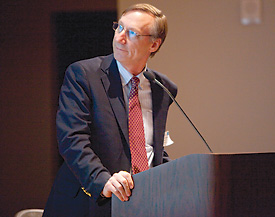Stephen Forrest has some idea of the issues likely to occupy his next term as vice president for research, but he also wants to be prepared for the unexpected opportunities he is certain will arise — just like they did in his first five years on the job.
Whether it’s working with the Native American community on transferring culturally unaffiliated human remains, or designing common job definitions and processes for U-M’s research faculty, or helping chart the future of the massive North Campus Research Complex, Forrest says, “Some of the biggest things that happen just walk in the door when you’re not paying attention.”

“Our job here at the University of Michigan is to try to anticipate trends, try to take advantage of what leverage we have, and try to shape the future, not be passive observers of it,” says Stephen Forrest, vice president for research. File photo, Lin Jones, U-M Photo Services.
“You can plan and plot many things — and that’s good, because you need to have a strategy to get things done — but I think some of the best things just come in, and the biggest opportunities walk in the door because you have your eyes open and you grab it as it flies by, and I like to think this office is reasonably good at doing that.”
The Board of Regents recently reappointed Forrest — who also is the William Gould Dow Collegiate Professor of Electrical Engineering, and a professor of electrical engineering and computer science, materials science and engineering, and physics — to a second five-year term as vice president for research.
Topics on Forrest’s to-do list for the next five years represent a continuation of effort from the last five.
A key focus will be expanding U-M’s engagement outside its academic boundaries by continuing to promote a culture of entrepreneurialism and expanding its portfolio of partners in business and industry.
He points to the creation of the Business Engagement Center and the Institute for Research on Labor, Employment and the Economy, as well as developing the NCRC, as illustrations of U-M’s commitment to helping revive and transform Michigan’s economy.
“Part of our public mission is to ensure that the state around us benefits from our presence in a tangible way,” he says. “If you’re going to live in an environment that you aspire to, you have to help create it. It’s really that simple.”
Other issues include:
• Continuing the university’s efforts to promote and develop sustainable technologies. Forrest cites the creation of the Michigan Memorial Phoenix Energy Institute as helping catalyze U-M’s push for sustainability.
“The establishment of the energy institute was an important step for the university to make a statement that we’re going invest significantly in one of the biggest problems facing humanity.”
• Globalizing U-M’s research by expanding on partnerships like the one recently signed with Shanghai Jiao Tong University of China.
“I would like to spend some time exploring other international opportunities with Europe, with Israel and, of course, to deepen our relationship with China.”
• Working with Indian tribes and researchers to resolve requests to transfer culturally unaffiliated human remains under the Native American Graves Protection and Repatriation Act.
“It’s very important that we get that one right,” Forrest says. “It has made me much more thoughtful about what I would call the social responsibility of research.”
Forrest’s reappointment comes after two straight years in which U-M surpassed the billion-dollar mark in research spending, reaching $1.14 billion in fiscal year 2010 and ranking first among public universities and colleges, and second overall, in a National Science Foundation measurement of research and development expenditures.
Forrest credits the university faculty with attaining those numbers “one grant at a time,” and says he wants his office to continue doing everything it can to make it easier for researchers to pursue their goals.
“I’m talking about (reducing) the time they spend working on administrative things. I’d like to see them more focused on what they really want to do, which is the research,” he says. “It’s pretty good here. That’s why we can do what we did. But if we could break down more barriers, incentivize faculty from the operational view, this will keep faculty enthusiastic and motivated to keep doing it.”
Much of the funding that fuels U-M research comes from federal sources, and while the university can encourage diversifying with industry partners, Forrest says the reality is that federal money will continue to dominate the landscape.
Given President Obama’s articulation of the importance of research, “We feel pretty confident that at least for the next two years, things will be on the same track. Whether they stay on that track, we don’t know.”
Forrest says it’s best that the university pursue federal dollars through competitive grant programs rather than earmarks, those targeted appropriations that individual lawmakers insert into legislation for specific projects in their districts. Earmarks, he says, can undermine the overall funding pool, whereas U-M is well equipped to go after the competitive dollars.
“We argue with a very clear voice in Washington for competitive programs, because if you look at how much money our university has received through earmarks in the past, versus what we get from competitive sources, there is no question competitive wins by this university vastly outstripped earmarks,” Forrest says.
The university’s impact on the funding process is an example of the leadership roles that U-M and its research play in the country and around the world.
“Our job here at the University of Michigan is to try to anticipate trends, try to take advantage of what leverage we have, and try to shape the future, not be passive observers of it. We simply cannot afford to be passive. We’re too big, we’re too important to the nation, both from the fact that we generate manpower and we generate so much knowledge,” Forrest says. “That’s what makes it fun being here. We can shape these things.”

